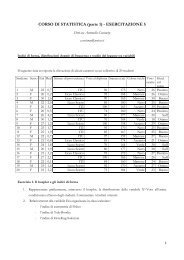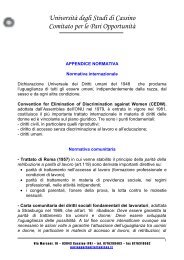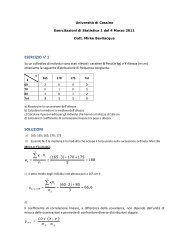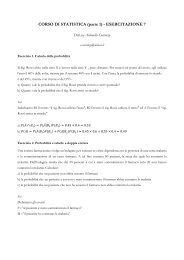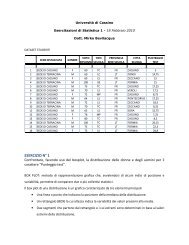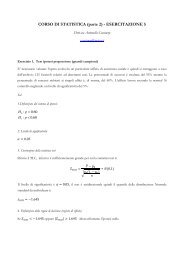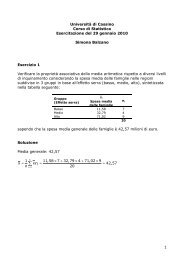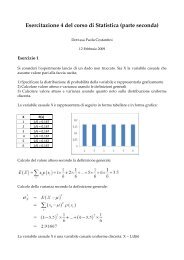Culturally-based beliefs and labour market institutions - dipse ...
Culturally-based beliefs and labour market institutions - dipse ...
Culturally-based beliefs and labour market institutions - dipse ...
You also want an ePaper? Increase the reach of your titles
YUMPU automatically turns print PDFs into web optimized ePapers that Google loves.
Table 1: EPL rigidity index <strong>and</strong> average replacement rate in 20 OECD CountriesCountry EPL EPL EPL RR RR RR1982 1992 2002 1982 1992 2002Australia 0.9 0.9 1.2 21.95 26.45 23.49Austria 2.2 2.2 2.2 32.67 34.8 38.96Belgium 3.2 3.2 2.2 51.225 47.95 45.49Canada 0.8 0.8 0.8 55.85 57.8 45.56Switzerl<strong>and</strong> 1.1 1.1 1.1 38.2 67.65 75Germany 3.2 3.2 2.35 39 38 37.95Denmark 2.3 2.3 1.4 79.25 75.5 64.42Spain 3.8 3.8 3.1 77.25 67.75 63.53Finl<strong>and</strong> 2.3 2.17 2 31.875 59.81 53.62France 2.78 3 3 59.5 58.4 61.3Great Britain 0.6 0.6 0.7 29.45 23.05 18.46Irel<strong>and</strong> 0.9 0.9 0.9 53.06 43.56 36.93Italy 3.6 3.6 2.13 1.81 8.81 58.31Japan 2.69 2.12 1.8 26.2 29.8 25.35Netherl<strong>and</strong>s 2.7 2.7 2.1 65 70 70.99Norway 2.9 2.9 2.6 48 61.5 63.79New Zeal<strong>and</strong> 0.9 0.9 1.5 29.42 29.29 27.96Portugal 4.1 3.85 3.7 23.64 65 69.66Sweden 3.5 3.5 2.2 84.1 87.25 75.77USA 0.2 0.2 0.2 32.55 25.15 29.19Source: Bassanini <strong>and</strong> Duval (2006)The twenty countries considered here can be divided into two groups: Australia,Canada, Great Britain, Irel<strong>and</strong>, New Zeal<strong>and</strong>, Switzerl<strong>and</strong>, USA are characterized by lowlevels of EPL stringency, while Austria, Belgium, Denmark, Finl<strong>and</strong>, France, Germany, Italy,Japan, Netherl<strong>and</strong>s, Norway, Portugal, Spain, Sweden display relatively high levels ofstringency. The Sc<strong>and</strong>inavian, Mediterranean (especially in the last decade) <strong>and</strong> CentralEuropean countries (with the exception of Austria <strong>and</strong> Germany) tend to exhibit moregenerous replacement rates than both the English-speaking European countries <strong>and</strong> otherextra-European countries (with the exception of Canada). We also create a normalized versionof EPL <strong>and</strong> RR dividing the indicators by the respective sample maximum. In figures 1a, 1b<strong>and</strong> 1c we plot the normalized RR against the normalized EPL for three years (1982, 1992,2002) in order to gain an immediate picture of different countries’ choices between regulation<strong>and</strong> benefits. The three figures suggest that there have been no major changes over time.UB generosity index0 .2 .4 .6 .8 1USAGBRCANIRENZLAUSCHEFigure 1aUB VS. EPL 1982DNKAUT FINNLDFRANORJPNBELDEUSWEITAESPPRT0 .2 .4 .6 .8 1index of strictness of EPLThe indexes are normalized dividing them by their maximum5
UB generosity index0 .2 .4 .6 .8 1USACANIRENZLAUSGBRCHEFigure 1bUB VS. EPL 1992FINDNKAUTJPNNLDNORFRABELDEUSWEITAESPPRT0 .2 .4 .6 .8 1i ndex of stri ctness of EPLThe indexes are normalized dividing them by their maximumUB generosity index.2 .4 .6 .8 1USAGBRCANIREFigure 1cUB VS. EPL 2002CHEAUSDNKNZLJPNFINNLDITASWEBELAUTDEUNORESPFRAPRT0 .2 .4 .6 .8 1index of strictness of EPLThe indexes are normalized dividing them by their maximumAs shown by table 2, which reports the stringency of EPL for regular <strong>and</strong> temporarycontracts, reforms in countries characterized by strict regulation have been implementedprincipally by giving greater flexibility to temporary contracts while leaving permanent onesunchanged, thereby creating a “dual” <strong>labour</strong> <strong>market</strong>.6
Table 2: EPL regular contracts <strong>and</strong> EPL temporary contractsCountryEPLreg EPL tempEPLreg EPL tempEPLreg EPL temp1982 1982 1992 1992 2002 2002Australia 1 0.875 1 0.875 1.5 0.875Austria 2.92 1.5 2.92 1.5 2.92 1.5Belgium 1.68 4.625 1.68 4.625 1.72 2.625Canada 1.32 0.25 1.32 0.25 1.32 0.25Switzerl<strong>and</strong> 1.16 1.125 1.16 1.125 1.16 1.125Germany 2.58 3.75 2.58 3.75 2.68 2.025Denmark 1.52 3.125 1.52 3.125 1.47 1.375Spain 3.88 3.75 3.88 3.75 2.61 3.5Finl<strong>and</strong> 2.78 1.875 2.47 1.875 2.17 1.875France 2.51 3.06 2.34 3.625 2.46 3.625Great Britain 0.95 0.25 0.95 0.25 1.12 0.375Irel<strong>and</strong> 1.6 0.25 1.6 0.25 1.6 0.25Italy 1.77 5.375 1.77 5.375 1.77 2.5Japan 2.38 3 2.44 1.8 2.44 1.25Netherl<strong>and</strong>s 3.08 2.375 3.08 2.375 3.05 1.19Norway 2.25 3.54 2.25 3.54 2.25 2.875New Zeal<strong>and</strong> 1.35 0.375 1.35 0.38 1.7 1.25Portugal 4.83 3.375 4.33 3.375 4.33 3Sweden 2.9 4.08 2.9 4.08 2.86 1.625USA 0.17 0.25 0.17 0.25 0.17 0.25Source: Bassanini <strong>and</strong> Duval (2006)The economic literature has proposed various explanations for these different attitudesto workers’ protection. Here we briefly discuss the most frequent of them.2. <strong>Culturally</strong>-<strong>based</strong> <strong>beliefs</strong> <strong>and</strong> the dem<strong>and</strong> for job protection2.1 Why protect workers <strong>and</strong> how?The economic literature puts forward two main explanations for the origin ofemployment protection legislation <strong>and</strong> unemployment benefits. On the one h<strong>and</strong>, there is thebelief that the existence of these <strong>labour</strong> <strong>market</strong> <strong>institutions</strong> reflects the equilibrium resultingfrom the interaction between insiders (employed workers) <strong>and</strong> outsiders (unemployedworkers). If the former have more political power, they are able to impose a system of jobprotection that strengthens their bargaining position at the expense of the unemployed <strong>and</strong> ofsociety as a whole (Saint-Paul 1993, 1996, 1997, 2002; Boeri et al. 2004). In this regard,Boeri et al. (2004) have shown the existence of a trade-off between EPL <strong>and</strong> UB, where thedifferent locations of countries along this continuum stem from heterogeneity in the skillslevels of labor force. In particular, they argue that, given the redistributive nature of EPL(from high-skilled to low-skilled workers), countries characterized by a less skilled laborforce <strong>and</strong> a compressed wage structure (with low wage differentials between high- <strong>and</strong> lowskilledworkers) should prefer EPL to UB.On the other h<strong>and</strong>, there is the view that employment protection legislation is aninstrument that furnishes social insurance to risk-adverse workers in an incomplete <strong>market</strong>context (Acemoglu <strong>and</strong> Shimer, 1999; Agell, 1999 <strong>and</strong> 2000; Bertola, 2004). According tothis approach, “[I]n the special case where workers’ marginal utility is constant, the modelillustrates the simple insights outlined above: EPL is neutral in steady state if it m<strong>and</strong>atesredundancy payments directly from employers to workers, <strong>and</strong> is welfare-decreasing if it7
(obedience, respect for the father, etc.) are given priority over all other values (autonomy,good civic attitudes, etc). The family comes first, <strong>and</strong> people outside the household areregarded with suspicion <strong>and</strong> considered untrustworthy. This ‘family-centered’ way of lifemay be an important determinant of the persistence of cultural traits.Empirical analysis has devoted by far the most attention to trust; by contrast, fatalismhas been treated in the medical <strong>and</strong> epidemiological literature but neglected by the economicliterature.Aghion et al. (2009) show that distrust in others is strongly positively correlated withvarious measures of regulation (product <strong>and</strong> labor <strong>market</strong> regulation, judicial procedure).Algan <strong>and</strong> Cahuc (2006a) note that the Danish flexicurity model, characterized by highunemployment benefits <strong>and</strong> low job protection, relies on strong public-spiritedness <strong>and</strong> ishardly implementable in the Continental <strong>and</strong> Mediterranean European countries, where thesevalues are less strong. Tabellini (2005) argues that culture, measured by indicators ofindividual values <strong>and</strong> <strong>beliefs</strong> such as trust, respect for others <strong>and</strong> confidence in the linkbetween effort <strong>and</strong> economic success, is a fundamental channel through which historyinfluences the functioning of current <strong>institutions</strong>. Barro <strong>and</strong> McCleary (2002) argued thatstronger religious <strong>beliefs</strong> stimulate economic growth because they sustain aspects ofindividual behavior that enhance productivity, <strong>and</strong> they viewed the relation between religion<strong>and</strong> economic growth as a causal one. Finally, Pinotti (2009) has developed a model whosemain conclusions are that, within each economy, the individual dem<strong>and</strong> for regulationdepends negatively on trust towards others, <strong>and</strong> that ignoring trust (as a proxy for averagetrustworthiness) biases estimations of the effects of <strong>market</strong> failures upwards.D’Orl<strong>and</strong>o <strong>and</strong> Ferrante (2009) argue that less educated workers with a fatalistic viewof life tend to dem<strong>and</strong> more job protection (where by ‘fatalistic view of life’ is meant apropensity to believe that life events are driven by fate rather than by actions). Wu (2005)analyzed the role of fatalism in determining household savings behavior, finding that peoplecharacterized by fatalistic <strong>beliefs</strong> are less likely to save. There is strong evidence in themedical literature on the role of fatalism in health screening behavior (Straughan <strong>and</strong> Seow1998, Nelson et al. 2002, Niederdeppe <strong>and</strong> Levy 2007). In particular, Nelson et al. (2002)showed that fatalism, viewed as a cultural belief closely bound up with ethnical origin, isassociated with delays in seeking health care.Licht et al. (2004) focus on three cultural traits: autonomy/embeddedness (relative tothe relation between individual <strong>and</strong> group), hierarchical/egalitarianism (relative to the ways inwhich socially responsible behavior is ensured), <strong>and</strong> mastery/harmony (relative tohumankind’s relations with the natural <strong>and</strong> social worlds). They find that countries oriented toautonomy <strong>and</strong> egalitarianism are characterized by better social <strong>institutions</strong> (greater rule oflaw, less corruption, more democratic accountability). In order to assess the causality fromculture to <strong>institutions</strong>, they used the grammar of pronouns as an instrumental variable forautonomy/embeddedness. Drawing on psychological evidence, they argued that languages inwhich it is permitted to drop the person-indexing pronouns (I, you, etc.) reflect a moreembedded culture. By contrast, languages that require the explicit use of pronouns place moreemphasis on a person’s contextualization <strong>and</strong> uniqueness.Finally, Algan <strong>and</strong> Cahuc (2006a) explain the difficulty of implementing a UB systemin the Continental <strong>and</strong> Mediterranean countries as due to a scarcity of public-spiritedness,which they view as culturally determined. The authors show that the stringency ofemployment protection in Mediterranean countries can be partly explained by cultural valuesembedded in religions. In particular they find that, compared to Catholic countries, Protestantones tend to reduce the level of employment protection, while Muslim <strong>and</strong> Orthodox ones(with a very similar effect) tend to increase it.9
2.3 Fate <strong>and</strong> FatalismAlthough the precise meaning of the word fatalism changes across cultures <strong>and</strong>religions, it can be linked with people’s propensity to believe that their destinies are ruled byan unseen power – Fate – rather than by their will. Indeed, the concept of locus of controldeveloped in psychology 3 is akin to the concept of fatalism, because moving from an internalto an external locus of control inevitably entails an increasingly fatalistic view of life.The concept of fatalism has been central to the development of religious <strong>and</strong>philosophical thought. Of course, this is not surprising because the question f whether or notour destinies are under our control is at the root of our thoughts <strong>and</strong> has shaped our culturalevolution. As in the case of trust, fatalism can be expected to be culturally transmitted fromone generation to the next. But there are differences regarding how fatalism is conceivedwithin different cultures <strong>and</strong> religions that should be taken into account when investigatingthe role of fatalism in different societies. In classical thought, as well as in Oriental religion,fate is a dark <strong>and</strong> sinister power related to a tragic vision of life. It connotes, not the absenceof freedom but the subjection of freedom. It is the transcendent necessity in which freedom isentangled. Fate is blind, inscrutable, <strong>and</strong> inescapable. Christianity substituted the Hellenisticconcept of fate with the doctrine of divine providence. Whereas fate is the portentous,impersonal power that rules over human freedom, providence liberates humankind to fulfillthe destiny for which it was created. Fate means the abrogation of freedom; providence meansthe realization of authentic freedom through submission to divine guidance. Fatalism waspresent among the ancient Stoics, <strong>and</strong> it pervades much of the thought of Hinduism,Buddhism, <strong>and</strong> Islam.2.4 Fatalism, trust in others <strong>and</strong> social protectionApart from their impact on other economic <strong>institutions</strong>, culturally-<strong>based</strong> <strong>beliefs</strong> areimportant elements to consider when seeking to explain the observed heterogeneity in howdifferent societies furnish job protection. Our contention is that fatalism <strong>and</strong> trust in othersplay a separate <strong>and</strong> essential role in the dem<strong>and</strong> for job protection <strong>and</strong>, more importantly, inthe choice of the preferred way to provide such protection.Fatalism <strong>and</strong> trust in others affect the dem<strong>and</strong> for protection through differentmechanisms. Drawing on D’Orl<strong>and</strong>o <strong>and</strong> Ferrante (2009) <strong>and</strong> extending their analysis on theempirical side, we suggest that the subjective cost of unemployment can be divided into amonetary cost (the income loss) <strong>and</strong> a psychological cost (the subjective perception of beingunable to cope with drastic negative changes in life). Fatalism affects the non-pecuniary,psychological costs of unemployment, i.e. a utility loss that does not disappear even if theincome loss is entirely off-set by unemployment benefits. The argument runs as follows.International evidence shows that more strictly regulated <strong>market</strong>s have lower inflow rates <strong>and</strong>outflow rates from unemployment. And the theoretical literature is unequivocal in arguingthat regulating a competitive <strong>labour</strong> <strong>market</strong> through employment protection legislation has noeffect on the average level of unemployment, although it increases the variability ofemployment (see among others Bertola <strong>and</strong> Rogerson 1997, Garibaldi 1998, Agell 1999,Fitoussi et al. 2000, Blanchard <strong>and</strong> L<strong>and</strong>ier 2001, Boeri <strong>and</strong> Garibaldi 2007, Freeman 2005).Hence, a typical worker should choose his/her preferred regime by comparing the pecuniary<strong>and</strong> non-pecuniary net-benefits of two alternative states of the world in which the averageunemployment rate is the same: one in which the <strong>labour</strong> <strong>market</strong> is regulated, so that thefrequency of unemployment is lower <strong>and</strong> its duration is longer, <strong>and</strong> another in which the3 Locus of control refers to a person's belief about what causes the good or bad results in his or her life, either ingeneral or in a specific area (Rotter, 1954; 1990). People’s locuses of control can be either internal or external,depending on whether or not they tend to believe that their actions ultimately determine personal outcomes.10
<strong>labour</strong> <strong>market</strong> is unregulated, so that the frequency is higher but the duration shorter.Typically, unemployment benefits compensate (at least in part) for the pecuniary lossesstemming from joblessness, but they are not designed to provide relief for the non-pecuniarylosses. By contrast, job protection can compress the non-pecuniary cost of unemployment byreducing the number of its episodes in a person’s working life. If this is so, then the choice ofseeking protection through stricter job security legislation is affected by the psychologicalfactors that determine the relative costs of episodes of unemployment as such, <strong>and</strong> theirlength. Moreover, in general, frequent episodes of unemployment affect workers more th<strong>and</strong>o a few longer episodes. The higher psychological costs of frequent episodes ofunemployment ensue from the circumstance that “individuals first reacted strongly tounemployment <strong>and</strong> then shifted back toward their former (or ‘baseline’) levels of lifesatisfaction. However, on average, individuals did not completely return to their former levelsof life satisfaction, even after they became re-employed. The findings suggests that even ashort period of unemployment can cause an alteration in a person’s long-term set-point”(Clark et al. 2004, p. 8). Hence, repeated episodes of unemployment have a negativepsychological impact that unemployment benefits are unable to remedy because the incomethat would be necessary to compensate people for the loss of well-being due tounemployment is very large; <strong>and</strong>, according to many authors (see e.g. Winkelmann <strong>and</strong>Winkelmann 1998, Di Tella, MacCulloch <strong>and</strong> Oswald 2003, Frey <strong>and</strong> Stutzer 2002), itimplies a replacement ratio much greater than one. Our argument is that the negativepsychological impact of this phenomenon is particularly severe for fatalistic people. The latterwould consequently prefer employment protection legislation which reduces unemploymentepisodes (even if it increases the duration of unemployment) rather than unemploymentbenefits which compensate only the monetary but not the psychological costs ofunemployment. Thus the varying impacts of these psychological costs on workerscharacterized by different degrees of fatalism can explain the different choices made bydifferent countries.Conversely, in light of Algan <strong>and</strong> Cahuc’s (2006a) findings, trust in others affects theexpected cost-effectiveness of social public expenditure, <strong>and</strong> in particular of UB, in providingprotection to those in need (Ferrante 2004). Empirical evidence furnishes strong support forthis view: social transfers have been shown to be less cost-effective than expected owing tovarious political <strong>and</strong> institutional failures. Notably, social transfers are difficult to allocateaccording to principles of progressivity, i.e. according to people’s real needs. In addition, alsobecause of their partially discretionary nature, they are fairly easily appropriated by rentseekers, free riders <strong>and</strong> special interest groups. Furthermore, tax <strong>and</strong> social contributionevasion can significantly affect the fiscal system’s ability to raise revenues <strong>and</strong> its degree ofprogressivity. Therefore, if average trust in others is low, reliance on social publicexpenditure <strong>and</strong> unemployment benefits as effective means to provide protection will be lowas well.Accordingly, our main prediction is that, in the absence of major political distortions,fatalism <strong>and</strong> the stringency of employment protection legislation (EPL) are positively related.Furthermore, we expect to find that the overall quality of the legal system affects people’sperceptions of the need for protection in the <strong>labour</strong> <strong>market</strong>.11
3. The empirical strategy3.1 The World Values SurveyThe World Values Survey (WVS) is a worldwide investigation of the basic values <strong>and</strong><strong>beliefs</strong> of individuals in a large cross-section of countries (more than 80) conducted by theWorld Values Survey Association. It has been carried out in four waves: 1980-1984 (20independent countries plus Northern Irel<strong>and</strong>), 1990-1994 (42 independent countries plusNorthern Irel<strong>and</strong>), 1994-1999 (53 independent countries plus Puerto Rico), 1999-2004 (69independent countries plus Northern Irel<strong>and</strong> <strong>and</strong> Puerto Rico). The survey containsinformation about demographics (sex, age, education, etc.), self-reported economicconditions, political preferences, attitudes, <strong>and</strong> religion. Table 3 reports summary statistics forthe variables used in our analysis, i.e. job security, fatalism <strong>and</strong> trust.Table 3: Summary StatisticsCountry Job Security* Fatalism** Trust* Country JobSecurity* Fatalism** Trust* CountryJobSecurity* Fatalism** Trust*ALB 0.833 5.369 0.256 DEU 0.734 6.976 0.341 PRT 0.692 6.692 0.174DZA 0.863 6.655 0.112 GBR 0.609 6.970 0.395 PRI 0.716 8.284 0.124ARG 0.619 7.210 0.202 GRC 0.653 7.000 0.269 ROU 0.749 6.426 0.150ARM 0.773 5.658 0.247 HUN 0.775 6.526 0.413 RUS 0.589 5.690 0.279AUS 0.622 7.402 0.431 ISL 0.506 7.375 0.379 SAU 0.666 6.604 0.530AUT 0.697 7.529 0.327 IND 0.839 6.243 0.516 SRB 0.500 6.030 0.276AZE 0.743 5.611 0.205 IDN 0.958 7.246 0.653 SGP 0.659 7.248 0.147BGD 0.872 5.977 0.222 IRN 0.771 6.618 0.415 SVK 0.690 6.456 0.213BLR 0.464 5.329 0.296 IRL 0.613 7.104 0.322 SVN 0.845 6.814 0.182BEL 0.426 6.505 0.313 ITA 0.642 6.231 0.422 ZAF 0.736 6.969 0.206BIH 0.883 6.004 0.219 JPN 0.673 5.713 0.277 KOR 0.658 6.716 0.328BRA 0.648 7.318 0.050 JOR 0.964 7.169 0.167 ESP 0.667 6.651 0.344BGR 0.725 5.564 0.286 KGZ 0.745 7.064 0.111 SWE 0.577 7.296 0.623CAN 0.665 7.535 0.455 MKD 0.876 5.921 0.188 CHE 0.683 7.184 0.370CHL 0.706 7.132 0.224 MLT 0.615 7.345 0.290 TWN 0.749 7.431 0.382CHN 0.610 6.970 0.553 MEX 0.662 7.618 0.184 TZA 0.793 5.800 0.081COL 0.371 7.888 0.112 MDA 0.845 5.914 0.228 TUR 0.963 5.291 0.129HRV 0.744 6.741 0.229 MAR 0.983 6.256 0.526 UGA 0.812 6.818 0.078CZE 0.599 6.660 0.267 NLD 0.365 6.256 0.491 UKR 0.721 5.236 0.297DNK 0.511 7.115 0.588 NZL 0.720 7.836 0.219 USA 0.726 7.591 0.415DOM 0.655 7.373 0.264 NGA 0.844 6.931 0.411 URY 0.771 7.020 0.216EGY 0.807 5.470 0.379 NIRL 0.701 7.231 0.639 VEN 0.872 8.013 0.137EST 0.557 6.119 0.242 NOR 0.753 7.013 0.082 VNM 0.821 7.492 0.411FIN 0.641 7.602 0.553 PER 0.479 7.065 0.269 ZWE 0.791 5.771 0.112FRA 0.435 6.352 0.228 PHL 0.749 6.918 0.071GEO 0.650 6.168 0.187 POL 0.702 6.189 0.267 Overall 0.683 6.644 0.301* Percentages; **MeanNote: Calculated on the four wavesThese variables have been determined in the following ways.1) Jobsecurity is a dummy variable that is equal to one if the respondent answers thatan important aspect of a job is “a good job security” to the following question: “Hereare some more aspects of a job that people say are important. Please look at them <strong>and</strong>tell me which ones you personally think are important in a job: good pay; not toomuch pressure; good job security; a job respected by people in general; good hours; anopportunity to use initiative; generous holidays; a job in which you feel you canachieve something; a responsible job; a job that is interesting; a job that meets one’sabilities”. We interpret this variable as a proxy for the dem<strong>and</strong> for job security amongindividuals. If workers believe that job security is important, they dem<strong>and</strong> it.2) Our measure of fatalism is <strong>based</strong> on answers to the following question: “Somepeople feel they have completely free choice <strong>and</strong> control over their lives, while otherpeople feel that what they do has no real effect on what happens to them. Please usethis scale (1 means “none at all” <strong>and</strong> 10 means “a great deal”) to indicate how much12
freedom of choice <strong>and</strong> control you feel you have over the way your life turns out.”Therefore the higher the value of the variable, the lower the individual’s fatalistictendencies. A similar definition of fatalism can be found in D’Orl<strong>and</strong>o <strong>and</strong> Ferrante(2008), Tabellini (2005) <strong>and</strong> Wu (2005).3) Trust measures the level of trust in other people <strong>and</strong> is <strong>based</strong> on answers to thefollowing question: “Generally speaking, would you say that most people can betrusted or that you need to be very careful in dealing with people?”. The variable isequal to one if participants report that most people can be trusted, <strong>and</strong> zero otherwise.An analogous definition of trust can be found for example in Guiso et al. (2002) or inAghion et al. (2008).The sample may be not representative for some poor countries. 4 In Nigeria, forexample, only more educated <strong>and</strong> wealthier people living in urban areas were interviewed. Totackle this problem, in the investigation reported here we always carried out a preliminaryanalysis which included all countries, followed by a further analysis limited to countries withmore reliable samples.3.2 The stability of culturally-<strong>based</strong> <strong>beliefs</strong>Theoretical reasoning as well as empirical evidence support the conclusion thatculturally-<strong>based</strong> <strong>beliefs</strong> are stable <strong>and</strong> exogenous with respect to <strong>institutions</strong> (Guiso et al.,2006). Nevertheless, to check whether fatalism <strong>and</strong> trust in others are sufficiently stablecultural traits at country level, we created a country index of fatalism (IF) <strong>and</strong> a country indexof trust in others (TO) for the first <strong>and</strong> the fourth wave of WVS investigation, <strong>and</strong> wecomputed the Pearson’s correlation coefficient for each indicator between the two periods. IFwas given by the mean fatalism at country level, 5 TO was the percentage of individuals whoanswered most people can be trusted to the relative question. We found a strong correlationacross periods for both IF <strong>and</strong> TO, respectively 0.6974 (sig. 0.0013) <strong>and</strong> 0.78 (sig. 0.0002). Infigures 2 <strong>and</strong> 3, we plot IF <strong>and</strong> TO calculated on the fourth wave against the same indexcalculated on the first wave. These results provide some support for the idea that fatalism <strong>and</strong>trust in others are stable culturally-<strong>based</strong> <strong>beliefs</strong> <strong>and</strong> that they can be treated as exogenousfactors in our estimations.4 In all the regressions reported, we used sample weights suggested by the survey’s authors to ensure that ourestimates were nationally representative for each country <strong>and</strong> each wave. However, the weights could not adjustcases where groups of the population were not samples at all. These countries with problems of nonrepresentativity that could not be corrected were (see the technical information athttp://www.worldvaluessurvey.org/ for detailed explanations): Argentina (first three waves), Bangladesh (thirdwave), Chile (last three waves), China (second <strong>and</strong> third wave), Dominican Rep. (third wave), Egypt (fourthwave), India (second <strong>and</strong> third wave), Mexico (second wave), Nigeria (second <strong>and</strong> third wave), South Africa(second wave).5 To consider the widest time interval available, we limited our analysis to only eighteen countries (Argentina,Belgium, Canada, Denmark, France, Germany, Hungary, Icel<strong>and</strong>, Irel<strong>and</strong>, Italy, Japan, South Korea, Malta,Netherl<strong>and</strong>s, Spain, Sweden, Great Britain, USA), which had been surveyed on both the first <strong>and</strong> the fourthwave.13
Index of Fatalism 2000.75 .8 .85 .9 .95 1KORITAJPNFigure 2Stability of FatalisnNLDBELFRAESPGBRHUNSWE DEU ARGMLTIRL DNKCAN ISL.7 .8 .9 1Index of Fatalism 1981The index of fatalism for the two periods is normalized dividing it for the sample maximumcorr=0.6974,sig=0.0013USAIndex of Trust 2000.2 .4 .6 .8 1ITABELFRAARGDEUHUNESPFigure 3Stability of TrustKORJPNISLUSA IRLNLDGBRCANDNKSWE.4 .6 .8 1Index of Trust 1981The index of trust for the periods is normalized dividing it for the sample maximumcorr=0.789,sig=0.00023.3 The determinants of fatalism <strong>and</strong> trust in othersBefore addressing the role played by fatalism <strong>and</strong> trust in others in the dem<strong>and</strong> of jobprotection in the OECD countries, it is convenient to analyze the socio-economic <strong>and</strong>demographic characteristics associated with these variables. For this purpose, we carried out apreliminary analysis of these cultural traits for the complete set of countries. The regressionsreported in table 4 exploit all four waves but exclude some countries 6 because we lackedinformation about variables crucial for our analysis (dem<strong>and</strong> of job security <strong>and</strong> fatalism). We6 Countries for which we did not have information about Job Security were: Colombia (third wave), El Salvador(third wave), Iraq (fourth wave), Israel (fourth wave), Rep. Of Korea (third wave), Pakistan (third wave <strong>and</strong>fourth wave), Pol<strong>and</strong> (second wave), South Africa (third wave) Countries for which we did not have informationabout fatalism were El Salvador (third wave), Israel (fourth wave), Pakistan (third <strong>and</strong> fourth wave), Iraq (fourthwave), Belarus (second wave), Colombia (third wave), Pol<strong>and</strong> (third wave), Turkey (second wave), Korea (thirdwave), South Africa (third wave), Switzerl<strong>and</strong> (second wave), Great Britain (third wave), Venezuela (fourthwave).14
an an ordered probit to establish if <strong>and</strong> how individual, cultural <strong>and</strong> institutionalcharacteristics (captured by country fixed effects) are associated with individual’s fatalism. Inso doing, we had two main purposes: to establish whether fatalism is a belief only determinedby objective individual characteristics (such as income, age, gender, health) or also bycultural legacy (as religion), <strong>and</strong> to explore the specific link between education <strong>and</strong> fatalism.In particular, building on D’Orl<strong>and</strong>o <strong>and</strong> Ferrante (2009), we expected to find that moreeducated people are less willing to believe that life-events are driven by fate rather than byactions. 7 Table 4 shows the results of the ordered probit of fatalism on individualcharacteristics, religious denomination, country fixed effects <strong>and</strong> wave fixed effects. Column(a) reports the results of the analysis for all the countries in the sample, while column (b)shows the previous regression on a sample where non-representative countries were excluded.The signs of the coefficients are those expected.The meaning of the great majority of variables is self-evident. As regards religion, wecreated a dummy variable termed ‘atheist’ if an individual did not belong to a religiousdenomination <strong>and</strong> a dummy for each of the other “dominant” religions 8 : Roman Catholic(indicated as romcatholic), Orthodox, Protestant, Muslim, Jewish, Buddhist, Hindu, Otherreligion (this has been indicated as otherrel <strong>and</strong> includes all religions different from theprevious ones). The relative question in WVS is the following: “Do you belong to a religiousdenomination? In case you do, answer which one”. Education was measured by age (wenamed this variable ageeduc) at which the interviewed had completed (or expected tocomplete) his/her education, excluding apprenticeships. 9 A similar measure for education canbe found in Guiso et al. (2002). We included a control for the respondent’s age in ouranalysis. To capture non-linear effects, we also included the square of age (agesquare). Tocapture gender effects we included a dummy variable (termed ‘female’) equal to one if therespondent’s sex was female. It is also like that the perceived state of health influencesfatalistic behavior. We consequently included this control as well, considering the question:“All in all, how would you describe your state of health these days? (1=very poor; 2 = poor;3 = fair; 4= good; 5 = very good)”. We created an indicator equal to one for each state ofhealth. These variables were respectively named vphealth, phealth, fhealth, ghealth, vghealth.For income we built three indicators of its level 10 which we named highincome,mediumincome, lowincome on the basis of the answers to the following question: “Here is ascale of incomes. We would like to know in what group your household is, counting all wages,salaries, pensions, <strong>and</strong> other income that comes in. Just give the letter of the group yourhousehold falls into, before taxes <strong>and</strong> other deductions” (income categories are coded bydecile for each society, 1=lowest decile, 10=highest decile).Table 4: Ordered Probit Fatalism7 We are aware that educational choices may be affected by people’s fatalism. In this case, there would be anendogeneity problem to deal with.8 By ‘dominant religions’ is meant religions with the highest numbers of followers.9We know that this measure may in some cases overestimate the level of education, so that the effect ofeducation may have been underestimated. Unfortunately, the alternative measure of education, i.e. the highestlevel of education achieved, is available only for a limited number of countries <strong>and</strong> not for all periods. However,we repeated the analysis using this alternative measure (hence with a lower number of observations) <strong>and</strong> weobtained very similar results.10 This division of income levels is the same as proposed by the survey authors. See the codebook of European<strong>and</strong> World Value Surveys Integrated data file at http://130.15.161.74/webdoc/ssdc/cdbksnew/wvs/3975_Codebook.pdf<strong>and</strong> http://www.nrf.ac.za/SADA/CodebookPDF/S0069.pdf for detailed information.15
Table 4: Ordered Probit Fatalism(a)(b)age ‐.00502*** age ‐.00505***(.00122) (.00128)agesquare .00005*** agesquare .00005***(.00001) (.00001)ageeduc .00602*** ageeduc .00626***(.00055) (.00058)female ‐.03380*** female ‐.03478***(.00613) (.00641)highincome .08097*** highincome .08178***(.00659) (.00694)lowincome ‐.07732*** lowincome ‐.07810***(.00729) (.00770)widowed ‐.02154 widowed ‐.02525(.01621) (.01698)separated .00613(.02569)separated ‐.00466(.02756)divorced ‐.02611 divorced ‐.02911*(.01670) (.01710)cohabitation ‐.03336** cohabitation ‐.02876*(.01481) (.01516)married ‐.01677* married ‐.01826*(.00894) (.00942)ghealth ‐.13001*** ghealth ‐.13023***(.00769) (.00825)fhealth ‐.24550*** fhealth ‐.24681***(.00910) (.00983)phealth ‐.42605*** phealth ‐.42905***(.01569) (.01670)vphealth ‐.52901*** vphealth ‐.53264***(.03936) (.04220)parttime .00469(.01067)parttime ‐.00076899(.01114)selfemployed .07992*** selfemployed .06885***(.01101) (.01204)retired ‐.01090 retired ‐.00498(.01247) (.01297)housewife ‐.04553*** housewife ‐.04579***(.01025) (.01093)student ‐.03554*** student ‐.03096**(.01296) (.01364)unemployed ‐.13304*** unemployed ‐.13826***(.01240) (.01305)otherjob ‐.08959*** otherjob ‐.07166***(.02458) (.02562)romcatholic ‐.01853** romcatholic ‐.01577*(.00905) (.00945)orthodox ‐.08529*** orthodox ‐.08649***(.01884) (.01942)protestant ‐.00042 protestant .00110(.01166) (.01198)jew ‐.09026* jew ‐.10385*(.05230) (.05425)hindu.06888* hindu.07976*(.03564) (.04634)muslim ‐.07724*** muslim ‐.08661***(.02138) (.02324)buddhist‐.01706 buddhist ‐.01690(.02418) (.02461)otherrel‐.01907 otherrel ‐.02294(.01526) (.01611)N 179930 N 163942Pseudo R2 .0221 Pseudo R2 .0235Controlling for country fixed effects <strong>and</strong> wave fixed effectsWhite robust st<strong>and</strong>ard errors are in brackets* p
As regards education, the coefficient of ageeducation takes a positive sign <strong>and</strong> ishighly significant. Hence when education increases, so too does the probability of being anon-fatalistic person. This supports our hypothesis that education can weaken the linkbetween transmitted culture <strong>and</strong> <strong>beliefs</strong> <strong>and</strong> make individuals more inclined to believe thatthey have greater control over life-events (this result holds in both samples). Unfortunately,we are unable to establish a causal link from education to fatalism because a higher level ofeducation may reflect an higher level of unobserved ability possessed by an individual, so thatthe decrease in fatalism may be caused by the individual’s higher skills. 11 Perhaps educationplays a role in this case, too, given that the technology of skill formation is characterized bystrong complementarities between cognitive skills <strong>and</strong> non-cognitive traits (Cuhna <strong>and</strong>Heckman, 2007) such as fatalism. Education improves people’s skills, <strong>and</strong> it may makeindividuals more aware of their abilities <strong>and</strong> therefore less fatalistic. To be on the safe side,we merely state that there is strong evidence for a negative relation between fatalism <strong>and</strong>education.Also the relation between health <strong>and</strong> fatalism takes the expected sign. The referenceclass is ‘very good health’: a worsening in the perceived state of health is accompanied by anincrease in fatalism.The effect of employment status also has the expected sign. Individuals who declarethat they are self-employed are less likely to be fatalistic (the reference category is full-timeworkers), while the probability of being fatalistic increases for housewives, unemployedpersons, <strong>and</strong> students. We are aware that the latter result may be due to reverse causality. Bydefinition, a non-fatalistic individual is someone who thinks that s/he has control over his/herlife, so that it is reasonable to assume that it is the latter attitude which influences the decisionto undertake self employment, <strong>and</strong> not vice-versa.Also gender plays a role in fatalistic attitudes, with women being more likely tobelieve that life-events are beyond their control. Of course, this can be rationalized in variousways mostly reliant on the impact of culture <strong>and</strong> education. Unfortunately, still today womenin many countries are far from being emancipated, <strong>and</strong> values transferred through culture <strong>and</strong>education tend to strengthen an antiquated vision of the female’s role. Hence, it is possiblethat this attitude towards women has generated a feeling of ‘resignation’. Indeed, thisinterpretation is to some extent supported by the sign of the coefficient of housewives.The analysis also suggests the existence of a non-linear relationship (reverse U-shaped) between age <strong>and</strong> fatalism: younger <strong>and</strong> older people seem to be less fatalistic.Finally, as far as religions are concerned, people declaring that they belong to areligion show a higher probability of being fatalistic. In particular, being ‘Orthodox’,‘Muslim’, ‘Jewish’ or ‘Catholic’ is positively correlated with the probability of beingfatalistic (with the first two results strongly statistically significant in both columns). Thesecond result is well known in sociology. The coefficients relative to ‘Protestant’ <strong>and</strong>‘Buddhist’ 12 take positive signs but are not statistically significant. The sign of ‘Hindu’ islikely to be due to problems with the Indian sample, because in the 1989-93 wave the samplewas designed so that 90 percent of respondents were literate (compared to a populationaverage of less than 50 percent). 13 Note that these signs are in line with the results obtainedby Algan <strong>and</strong> Cahuc (2006b).11 See Griliches (1977) <strong>and</strong> Card (2001) for a discussion on the ability bias.12Probably, the effect of Buddhist affiliation is captured by the dummy relative to Japan. Algan <strong>and</strong> Cahuc(2006b) report that Buddhist affiliation is almost perfectly correlated with Japan.13 In 1999-2004, the survey was designed to be representative of 97% of the population. However, in this casetoo, no sample weights were provided.17
The overall implications of these data confirm our hypothesis that income, education,age (up until a certain age), health, employment status, <strong>and</strong> being male exert a negative effecton fatalism. Still to be discussed is the impact of fatalism on the dem<strong>and</strong> for job security.3.4 Cultural <strong>based</strong> <strong>beliefs</strong> <strong>and</strong> dem<strong>and</strong> for job protectionThe next step is to consider whether <strong>and</strong> how these cultural traits affect the dem<strong>and</strong>for job protection. Columns (a) <strong>and</strong> (b) of table 5 set out the results of a probit regression ofJobSecurity on fatalism <strong>and</strong> trust, controlling for country <strong>and</strong> wave fixed effects,demographic characteristics (gender, age, education, marital status <strong>and</strong> health status),economic characteristics (level of income, employment status) <strong>and</strong> religion. Column (a) isrelative to the entire sample, while the analysis reported in column (b) is limited, as usual, torepresentative countries. Column (c) reports the results of a Linear Probability Model on thesame sample of column (b).The signs <strong>and</strong> the statistical significance of the coefficients are the same in the threecolumns, with the exception of fatalism, which in column (a) is significant only at 10% level.This is probably due to the over-representation of wealthier <strong>and</strong> more educated people insome samples extracted from poor countries. As we noted with reference to table 4, bothincome <strong>and</strong> education can influence fatalism, so this over-representation may mitigate itseffects, although they are still statistically significant.As we expected, dem<strong>and</strong> for job protection is increasing in fatalism <strong>and</strong> decreasing intrust in others. Interestingly, more educated people are less willing to dem<strong>and</strong> job security,confirming the idea that education can reduce the perception of unemployment risk(D’Orl<strong>and</strong>o <strong>and</strong> Ferrante, 2009).The analysis also shows that there is a gender effect in the dem<strong>and</strong> for job protection:being female reduces the probability of dem<strong>and</strong>ing job security. This result seems to contrastwith the analysis reported in table 4, where we showed that females are more likely to befatalistic. However, we controlled the effect of fatalism, so this coefficient should beinterpreted as the net effect of gender. Furthermore, this result partly confirms (see also theresult relative to housewife) the idea put forward by Algan <strong>and</strong> Cahuc (2006b) that jobprotection is more favorable to male insiders than to femalesAs to be expected, income (the reference is medium income) exerts a negative impacton the dem<strong>and</strong> for job security. In comparison to singles, married individuals tend to dem<strong>and</strong>more job security, while separated individuals do so to a lesser extent. Another result in linewith our expectations concerns the impact of employment status. In the case of ‘full timeworkers’, we find a decrease in the probability of dem<strong>and</strong>ing job security with respect to allthe other employment statuses, with a particularly strong effect for ‘self-employed’ <strong>and</strong> ‘parttime workers’. With the exception of ‘retired’, all the coefficients are statistically significantat 1% level.Building on the latter reassuring results, we now restrict our discussion to a morereliable sample which enabled us to enrich the analysis by including institutional variables.18
Table 5: Dem<strong>and</strong> for Job Security vs. Fatalism <strong>and</strong> TrustTable 5: Dem<strong>and</strong> for Job Security Vs. Fatalism <strong>and</strong> Trust(a) (b) (c)fatalism ‐.00328* fatalism ‐.00423** fatalism ‐.00141**(.00171) (.00182) (.00057)trust ‐.11232*** trust ‐.1112*** trust‐.03835***(.00841) (.00884) (.00301)age .00491*** age .00515*** age.00171***(.00158) (.00165) (.00055)agesquare ‐.00006*** agesquare ‐.00007*** agesquare ‐.00002***(.00002) (.00002) (6.017e‐06)ageeduc ‐.01079*** ageeduc ‐.01107*** ageeduc ‐.00374***(.00070) (.00075) (.00025)female ‐.03999*** female ‐.04455*** female ‐.01522***(.00834) (.00871) (.00289)highincome ‐.07075*** highincome ‐.07510*** highincome ‐.02412***(.00938) (.00987) (.00328)lowincome .00759 lowincome .00620 lowincome.00178(.00951) (.01004) (.00324)widowed .02673 widowed .02996 widowed.00942(.02059) (.02146) (.00724)separated ‐.04822(.03004)separated ‐.05628*(.03199)separated ‐.02134*(.01129)divorced .04326** divorced .04053* divorced.01366*(.02157) (.02199) (.00750)cohabitation .05298*** cohabitation .04871** cohabitation.01493**(.01970) (.02041) (.00683)married .07782*** married .08013*** married.02601***(.01195) (.01257) (.00418)parttime ‐.12860*** parttime ‐.14060*** parttime ‐.04805***(.01479) (.01547) (.00529)selfemployed ‐.24996*** selfemployed ‐.27223*** selfemployed ‐.08945***(.01436) (.01574) (.00515)retired ‐.02842* retired ‐.03401** retired ‐.01030*(.01626) (.01683) (.00559)housewife ‐.08760*** housewife ‐.08337*** housewife ‐.02737***(.01379) (.01466) (.00480)student ‐.08382*** student ‐.09125*** student ‐.02994***(.01795) (.01907) (.00629)unemployed ‐.04473*** unemployed ‐.05169*** unemployed ‐.01785***(.01616) (.01694) (.00523)otherjob ‐.09289*** otherjob ‐.10589*** otherjob ‐.03394***(.03268) (.03457) (.01085)Controls for health status yes Controls for health status yes Controls for health status yesControls for religions yes Controls for religions yes Controls for religions yesN 171782 N 156413 N 156413Pseudo R2 .0904 Pseudo R2 .0951 R2 .1115Controlling for country fixed effects <strong>and</strong> wave fixed effectsWhite robust st<strong>and</strong>ard errors are in brackets* p
We first estimated a model of the determinants of the dem<strong>and</strong> for job securitycontrolling for country <strong>and</strong> wave fixed effects; the idea being that the latter effects wouldenable us to control for differences among the overall institutional settings of countries. Wethen estimated a model including explicit controls for <strong>labour</strong> <strong>market</strong> <strong>institutions</strong> (EPL, SPE<strong>and</strong> UB) <strong>and</strong> for the quality of the legal system. The idea in this case was that people areconcerned about the actual level of protection, i.e. the nominal level adjusted for the extentto which regulations are legally enforced. Moreover, we expected that the dem<strong>and</strong> forprotection would be determined also by the overall quality of the legal system. To control forthese factors we adopted the index of the legal structure <strong>and</strong> security of property rights(legalprop) proposed by Gwartney <strong>and</strong> Lawson et al. (2009). This index ranges from 0-10,where 0 corresponds to ‘no judicial independence’, ‘no trusted legal framework exists’, ‘noprotection of intellectual property’, ‘no integrity of the legal system’ <strong>and</strong> 10 corresponds to‘high judicial independence’, ‘trusted legal framework exists’, ‘protection of intellectualproperty’, ‘integrity of the legal system’.The purpose of the analysis was to verify whether protection provided to workersthrough EPL, SPE <strong>and</strong> UB reduces, as we expected, the dem<strong>and</strong> for job security <strong>and</strong> whetherthe quality of the legal system affects the latter outcome. Following Tabellini (2005) <strong>and</strong>Aghion et al. (2008), we also expected that the better the quality of the legal system, the lowerthe dem<strong>and</strong> for regulatory <strong>institutions</strong> would be.As preliminary evidence on the relation between culturally-<strong>based</strong> <strong>beliefs</strong> <strong>and</strong> <strong>labour</strong>14<strong>market</strong> <strong>institutions</strong>, figure 4a <strong>and</strong> figure 4b show respectively the normalized versions ofEPL <strong>and</strong> RR (1992 <strong>and</strong> 2002) <strong>and</strong> SPE (1990 <strong>and</strong> 2000) plotted against IF calculated for thesecond <strong>and</strong> fourth waves. IF appears to be correlated with the measure of EPL strictness (thecorrelation coefficient takes a value of -0.52, p < 0.0007), while there is no evidence ofcorrelation between IF <strong>and</strong> SPE <strong>and</strong> between IF <strong>and</strong> RR (the coefficients of correlation arenot statistically different from zero). Since IF is higher, fatalism is lower, <strong>and</strong> the negativecorrelation with EPL takes the expected sign.Figure 4Figure 4aEPL <strong>and</strong> RR VS. FatalismEPL;RR0 .2 .4 .6 .8 1.7 .8 .9 1Index of FatalismEPL VS. FATALISMRR VS. FATALISMpwcorr(IF;EPL)=-0.5240 pvalue:0.0007; pwcorr(IF;RR)=-0.0156 pvalue:0.9261The indexes are normalized dividing them by their maximum14 The sample of countries is the same as in table 2. However, because of problems of non-availability of IF wewere forced to consider only one period for Australia (the second wave) <strong>and</strong> for New Zeal<strong>and</strong> (the third wave).20
Figure 4bSPE VS. FatalismSPE.4 .6 .8 1.7 .8 .9 1Index of Fatalismpwcorr (SPE;IF)= - 0.2347 p-value: 0.1561The index of fatalism is normalized dividing it for the sample maximumFigure 5a <strong>and</strong> Figure 5b show the same preliminary analysis for trust in others. Wefind that trust is weakly positively correlated with RR, i.e. the correlation coefficient takes avalue of 0.29 (p
Figure 5bSPE VS. TrustSPE.4 .6 .8 1.2 .4 .6 .8 1Index of Trustpwcorr (SPE;TO)= - 0.1898 p-value: 0.2538The index of trust is normalized dividing it for the sample maximumTo be stressed is that the econometric analysis reported in this section should not to betaken as an attempt to establish causal links: to simplify the exposition, we refer to theimpacts of fatalism (or of impacts on fatalism), but these should be interpreted as correlations.Table 6 repeats the analysis shown in table 5 but with attention restricted to the 20OECD countries, <strong>and</strong> adding controls for EPL, UB <strong>and</strong> SPE, the quality of the legal system(legalprop), the interaction between stringency of EPL <strong>and</strong> the quality of the legal system,(legepl), <strong>and</strong> the interaction between the quality of the legal system <strong>and</strong> generosity of SPE<strong>and</strong> UB (legspe, legub). Column (a) shows the results of a probit regression controlling forcountry <strong>and</strong> wave fixed effects. In Column (b) we add controls for EPL <strong>and</strong> UB <strong>and</strong> forlegality, while in column (c) we use SPE instead of UB. Fatalism <strong>and</strong> trust in others arestrongly statistically significant in all the models; the coefficients take the expected sign; <strong>and</strong>the coefficients are larger than in the previous sample. The results for the other controls arevery similar to those reported in table 6.The impacts on the dem<strong>and</strong> for job security from <strong>labour</strong> <strong>market</strong> <strong>institutions</strong> are thoseexpected. It can be straightforwardly checked that an increase in either EPL or UB leads to adecrease in the dem<strong>and</strong> for job security. This appears to contrast with the results obtained byClark <strong>and</strong> Postel-Vinay (2005), who found a negative impact of EPL on the perception of jobsecurity, <strong>and</strong> a positive impact of UB. Therefore, if one controls for subjective culturally<strong>based</strong><strong>beliefs</strong> <strong>and</strong> for the quality of the legal system, EPL does not appear to reduce workers’perceived security. A corollary of this result is that observed international differences in thelevel of <strong>labour</strong> <strong>market</strong> regulation should be attributed, at least in part, to underlyingdifferences in the quality of legal systems. Finally, the effects of the interactions between<strong>labour</strong> <strong>market</strong> <strong>institutions</strong> <strong>and</strong> the quality of legal systems appear quite complex <strong>and</strong> nonlinear.22
Table 6 : Dem<strong>and</strong> for Job Security Vs. Fatalism <strong>and</strong> Trust for 20 OECD countries(a) (b) (c)fatalism ‐.01592*** fatalism ‐.01631*** fatalism ‐.01522***(.00327) (.00327) (.00327)trust ‐.13926*** trust ‐.13800*** trust‐.13638***(.01341) (.01345) (.01345)age .00429* age .00525** age.00499*(.00259) (.00259) (.00259)agesquare ‐.00004(.00003)agesquare ‐.00005**(.00003)agesquare ‐.00005*(.00003)ageeduc ‐.01273*** ageeduc ‐.01442*** ageeduc ‐.01486***(.00120) (.00123) (.00124)female ‐.04260*** female ‐.04461*** female ‐.0440***(.01426) (.01428) (.01428)highincome ‐.09645*** highincome ‐.08436*** highincome ‐.09588***(.01588) (.01598) (.01597)lowincome ‐.01700 lowincome ‐.01296 lowincome‐.01250(.01657) (.01665) (.01667)parttime ‐.13781*** parttime ‐.13245*** parttime ‐.13519***(.02456) (.02458) (.02458)selfemployed ‐.34343*** selfemployed ‐.35265*** selfemployed ‐.34824***(.02704) (.02704) (.02698)retired ‐.03052 retired ‐.01694 retired‐.02031(.02610) (.02615) (.02614)housewife ‐.06680*** housewife ‐.06008** housewife ‐.06095**(.02410) (.02410) (.02410)student ‐.06495* student ‐.05042 student‐.05447(.03390) (.03400) (.03399)unemployed ‐.02995 unemployed ‐.02620 unemployed‐.02643(.02999) (.03009) (.03008)otherjob ‐.04843 otherjob ‐.04995 otherjob‐.04658(.04860) (.04876) (.04856)epl ‐.58447*** epl ‐.82448***ub(.22118)‐.07037*** spe(.21316).19682***legalprop(.01102)‐.61189*** legalprop(.02497)‐.03284(.07087) (.08578)legepl.05813*** legepl.11559***(.02344) (.02167)legub .00876***(.00126)legspe ‐.02108***(.00298)Controls for marital status yes Controls for marital status yes Controls for marital status yesControls for religions yes Controls for religions yes Controls for religions yesControls for health status yes Controls for health status yes Controls for health status yesControls for religions yes Controls for religions yes Controls for religions yesN 53968 N 53968 N 53968Pseudo R2 .0567 Pseudo R2 .0597 R2 .0599Controlling for country fixed effects <strong>and</strong> wave fixed effectsWhite robust st<strong>and</strong>ard errors are in brackets* p
Like Aghion et al. (2008), we find that trust in others is negatively related to thedem<strong>and</strong> for job security <strong>and</strong>, like Ferrante <strong>and</strong> D'Orl<strong>and</strong>o (2008 <strong>and</strong> 2009), we find a positiverelation between fatalism <strong>and</strong> the dem<strong>and</strong> for job security. In contrast to Clark <strong>and</strong> Postel-Vinay (2005), our estimates show that both employment protection legislation <strong>and</strong>unemployment benefits are effective means to provide protection. Finally, our data suggestthat the quality of the legal system matters in the determination of people’s dem<strong>and</strong> forprotection.In economics, <strong>and</strong> in democratic regimes, people’s preferences are assumed to be thebenchmarks against which to evaluate the goodness of institutional <strong>and</strong> economic outcomes.Data seem to show that OECD countries are characterized by different national cultural traits<strong>and</strong> that the latter determine the dem<strong>and</strong> for job protection <strong>and</strong>, most importantly, how suchprotection should be provided. Nevertheless, the role of country-specific preferences is oftenneglected in the economic analysis of <strong>labour</strong> <strong>market</strong> <strong>institutions</strong>. Indeed, if one believes indemocratic processes, leaving preferences aside may lead to wrong conclusions on thedesirability of different institutional regimes <strong>and</strong> on the political feasibility <strong>and</strong> optimaltiming of institutional reforms.The role of education in compressing the cost of unemployment risks emerges clearlyfrom our exercise: education seems negatively affect the dem<strong>and</strong> for job protection bothdirectly <strong>and</strong> indirectly, i.e. through its impact on fatalism. This result is not surprising, <strong>and</strong> itconfirms that the most cost-effective way to inject flexibility into labor <strong>market</strong>s is tocompress workers’ psychological costs of facing unemployment risks through the provisionof education.As a final remark, our exercise confirms that culturally-<strong>based</strong> preferences <strong>and</strong> attitudescannot be omitted from economic analysis because they shape people’s expectationsconcerning the link between actions <strong>and</strong> outcomes. And, indeed, besides trust, also fatalismseems to play an important part in this context.ReferencesAcemoglu, D., Shimer, R., (1999). “Efficient Unemployment Insurance”, The Journal ofPolitical Economy, 107(5), pp. 893-928.Agell J. (1999). “On the benefits from rigid <strong>labour</strong> <strong>market</strong>s: norms, <strong>market</strong> failures, <strong>and</strong>social insurance”, Economic Journal, 109(453), 143-164.Agell, J., (2000). “On the determinants of <strong>labour</strong> <strong>market</strong> <strong>institutions</strong>: Rent seeking vs. socialinsurance”, CESIFO Working Paper No. 384.Aghion, P., Algan,Y, Cahuc, P.,Shleifer,A., (2009). “Regulation <strong>and</strong> Distrust” NBER Working Paper No. 14648.Akerlof, George A. <strong>and</strong> Kranton Rachel E. (2000), “Economics <strong>and</strong> Identity”, QuarterlyJournal of Economics, 115(3), pp.715-53.Algan,Y., Cahuc, P., (2006a). “Civic Attitudes <strong>and</strong> the Design of Labour Market Institutions:Which Countries Can Implement the Danish Flexicurity Model?”, CEPR DiscussionPapers 5489.Algan,Y., Cahuc,P., (2006b). “Job Protection: The Macho Hypothesis”, Oxford Review ofEconomic Policy, 22(3), pp 390-410.Barro, R.J., Mc Cleary,R., (2003).“Religion <strong>and</strong> Economic Growth”, NBER Working PaperNo. W9682.Bassanini, A., Duval,R., (2006). “Employment patterns in OECD Countries: Reassessing therole of policies <strong>and</strong> <strong>institutions</strong>”, Social, Employment <strong>and</strong> Migration Working PapersNo. 35, OECD.24
Bertola, G. <strong>and</strong> Rogerson, R. (1997). “Institutions <strong>and</strong> Labor Reallocation”, EuropeanEconomic Review, 41(6), 1147-1171.Bertola, G., (2004). “A Pure Theory of Job Security <strong>and</strong> Labour Income Risk”, The Review ofEconomic Studies, 71(1), pp. 43-61.Blanchard O. <strong>and</strong> L<strong>and</strong>ier A. (2001). "The Perverse Effects of Partial LaborMarket Reform: Fixed Duration Contracts in France”, NBER Working Paper 8219,April 2001.Boeri, T., Conde-Ruiz, J.I., Galasso,V., (2004). “Cross-Skill Redistribution <strong>and</strong> the Tradeoffbetween Unemployment Benefits <strong>and</strong> Employment Protection”, IZA Discussion PaperNo. 1371.Boeri,T., Garibaldi P.,(2007). “Two Tier Reforms of Employment Protection: A HoneymoonEffect?”, Economic Journal, Vol. 117, No. 521, pp. 357-385.Card, D., (2001). “Estimating the Return to Schooling: Progress on Some PersistentEconometrica Problems”, Econometrica, 69(5), pp. 1127-1160.Clark A., Diener E., Georgellis Y., Lucas R (2004). "Unemployment Alters the Set-Point forLife Satisfaction", Psychological Science, 15, pp.8-13.Clark, A., Postel-Vinay, F., (2005). Job Security <strong>and</strong> Job Protection, IZA Discussion PaperNo. 1489.Church A. Timothy, (2000). “Culture <strong>and</strong> Personality: Toward an Integrated Cultural TraitPsychology”, Journal of Personality, 68:4, pp. 651-703.Cunha, F., <strong>and</strong> Heckman J. (2007). “The Technology of Skill Formation”, AmericanEconomic Review. May, 97(2): 31-47.Di Tella R., MacCulloch R. <strong>and</strong> Oswald A. (2003). “The Macroeconomics of Happiness”,Review of Economics <strong>and</strong> Statistics, 85(4),809-827.D’Orl<strong>and</strong>o, F. <strong>and</strong> Ferrante, F. (2008). “Why do similar countries have different <strong>labour</strong><strong>market</strong> regulations?”, La Comunità Internazionale, Vol. LXII, n.1, primo trimester.D’Orl<strong>and</strong>o, F. <strong>and</strong> Ferrante, F. (2009). “The Dem<strong>and</strong> for Job Protection. Some Clues fromBehavioural Economics”, The Journal of Socio Economics, 38 (1), pp. 104-114.Ferrante, F. (2004), “Employment protection legislation <strong>and</strong> redistribution”, Quaderno ISEn.132, LUISS, Roma. gennaio.Fitoussi, J.-P., Jestaz, D., Phepls E.S. <strong>and</strong> Zoega G. (2000). “Root of the Recent Recoveries:Labor Reforms or Private Sector Forces?”, in Brooking Papers on EconomicActivity, 0(1), 237-91.Freeman R. (2005) “Labour Market Institutions without Blinders: The Debateover Flexibility <strong>and</strong> Labour Market Performance”, NBER Working Paper 11286.Frey, B. <strong>and</strong> Stutzer, A. (2002). “What can Economists Learn from Happiness Research?”,Journal of Economic Literature, vol. XL, June, 402-435?EUROPEAN AND WORLD VALUES SURVEYS FOUR-WAVE INTEGRATED DATAFILE, (1981-2004). v.20060423, 2006. The European Values Study Foundation <strong>and</strong>World Values Survey Association. Aggregate File Producers: ASEP/JDS, Madrid,Spain/Tilburg University, Tilburg, the Netherl<strong>and</strong>s. Aggregate File Distributors:ASEP/JDS <strong>and</strong> ZA, Cologne, Germany.Garibaldi, P. (1998). “Job Flows Dynamics <strong>and</strong> Firing Restrictions”, European EconomicReview, 42(2), 245-275.Griliches, Z., (1977). “Estimating the Returns to Schooling: Some Econometric Problems”,Econometrica, 45(1), pp. 1-22.Guiso, L., Sapienza, P., Zingales, L., (2002). “People's Opium? Religion <strong>and</strong> EconomicAttitudes”, NBER Working Papers 9237Guiso, L., Sapienza, P., Zingales, L., (2006). “Does Culture affect Economic Outcome?”Journal of Economic Perspectives, 20(2), pp 23–4825
Guiso, L., Sapienza, P., Zingales, L., (2009). “Cultural Biases in Economic Exchange”Quarterly Journal of Economics, 124 (3), pp. 1095-1131.Gwartney, J. <strong>and</strong> Lawson, R. 2009. Economic Freedom of the World: 2009 Annual Report.Vancouver: The Fraser Institute.Licht, A.N., Goldschmidt, C., Schwartz, S.H., (2004). “Culture Rules: the Foundations of theRule of Law <strong>and</strong> Other Norms of Governance”, mimeo, UC Berkeley School of Law.Nelson, K., Geiger, A.M., Mangione, C.M. (2002). “Effect of Health Beliefs on Delays inCare for Abnormal Cervical Cytology in a Multiethnic Population”, Journal ofGeneral Internal Medicine, 17(9), pp 709–716.Nicoletti, G., Scarpetta, S., Boylaud, O., (2000). “Summary Indicators of Product MarketRegulation with an Extension to Employment Protection Legislation.”, OECDEconomics DepartmentWorking Papers 226, OECD Economics Department.Niederpeppe, J., Gurmankin Levy, A., (2007) “Fatalistic Beliefs about Cancer Prevention<strong>and</strong> Three Prevention Behaviors”, Cancer Epidemiology, Biomarkers & Prevention,16(5), pp. 998-1003.Pinotti, P. (2009). “Trust <strong>and</strong> regulation: addressing a cultural bias”, Temi di discussione,Banca d’Italia, n. 721.Rotter, J.B. (1954). “Social learning <strong>and</strong> clinical psychology”, New York: Prentice-Hall.Rotter, J. B. (1990). “Internal versus external control of reinforcement: A case history of avariable”, American Psychologist, 45, 489-493.Saint-Paul, G., (1993). “On the Political Economy of Labour Market Flexibility”, NBERMacroeconomics Annual.Saint-Paul, G., (1996). “Exploring the political economy of <strong>labour</strong> <strong>market</strong> flexibility”,Economic Policy (23), pp. 265–300.Saint-Paul, G., (1997). “Is <strong>labour</strong> rigidity harming Europe’s competitiveness? The effect ofjob protection on the pattern of trade”, European Economic Review, 41, pp. 499–506.Saint-Paul, G., (2002). “The Political Economy of Employment Protection”, The Journal ofPolitical Economy, 110(3), pp. 672-704.Straughan, P.T., Seow, A, (1998). “Fatalism Reconceptualized: A Concept to Predict HealthScreening Behavior”, Journal of Gender, Culture, <strong>and</strong> Health, 3(2).Tabellini, G., (2005). “Culture <strong>and</strong> Institutions: Economic Development in the Regions ofEurope”, CESIFO Working Paper No. 1492.Winkelmann L., Winkelmann R. (1998),”Why Are Unemployed so Unhappy? Evidence fromPanel Data”, Economica, 65(257), 1-15,Wu,S.(2005).“Fatalistic Tendencies: An Explanation of Why People Don’t Save”,Contributions to Economic Analysis & Policy,http://www.bepress.com/bejeap/contributions/vol4/iss1/art126
APPENDIXTable 7a: Summary statistics*variable N mean sdtrust 255399 .29548 .45626fatalism 248224 6.64010 2.44455jobsecurity 248476 .68234 .46557age 264839 41.23718 16.33260ageeduc 196380 18.27410 5.95704female 267870 .51920 .49963married 267870 .58887 .49204cohabitation 267870 .04164 .19976divorced 267870 .03604 .18640separated 267870 .01510 .12194widowed 267870 .06577 .24787single 267870 .23408 .42342lowincome 267870 .28711 .45241mediumincome 267870 .31392 .46409highincome 267870 .24839 .43208vghealth 267870 .18332 .38693ghealth 267870 .31702 .46531fhealth 267870 .23815 .42595phealth 267870 .05764 .23306vphealth 267870 .01022 .10058fulltime 267870 .37930 .48521selfemployed 267870 .08351 .27666parttime 267870 .07161 .25784retired 267870 .13492 .34163housewife 267870 .13939 .34636student 267870 .06714 .25026unemployed 267870 .07695 .26651otherjob 267870 .01664 .12791romcatholic 267870 .32641 .46890muslim 267870 .11279 .31634orthodox 267870 .07638 .26561protestant 267870 .14009 .34708jew 267870 .00651 .08045buddhist 267870 .01455 .11974hindu 267870 .02379 .15239otherrel 267870 .06373 .24427atheist 267870 .19094 .39304* The sample is the same of table 5 (column a)27
Table 7b: Summary statistics*variable N mean sdtrust 62163 .40447 .49079fatalism 64501 6.99561 2.07354jobsecurity 64488 .63500 .48143age 65696 44.84364 17.19697ageeduc 58053 18.34367 5.85693female 65921 .52821 .49921married 65921 .57983 .49359cohabitation 65921 .05182 .22166divorced 65921 .05061 .21919separated 65921 .01732 .13048widowed 65921 .07521 .26373single 65921 .22104 .41495lowincome 65921 .26482 .44124mediumincome 65921 .30895 .46206highincome 65921 .24651 .43098vghealth 65921 .20829 .40609ghealth 65921 .30063 .45854fhealth 65921 .17641 .38117phealth 65921 .03947 .19472vphealth 65921 .00843 .09145fulltime 65921 .41321 .49241selfemployed 65921 .05842 .23453parttime 65921 .08563 .27982retired 65921 .18225 .38605housewife 65921 .12697 .33294student 65921 .05494 .22787unemployed 65921 .05249 .22301otherjob 65921 .01670 .12815romcatholic 65921 .41859 .49333muslim 65921 .00358 .05973orthodox 65921 .00279 .05276protestant 65921 .24473 .42993jew 65921 .00347 .05884buddhist 65921 .01789 .13253hindu 65921 .00103 .03210otherrel 65921 .05491 .22781atheist 65921 .24402 .42951*The sample is the same of table 628




